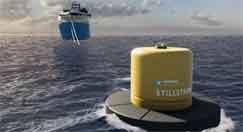With growing interest in battery-powered container ships to reduce CO2 emissions, container shipping giant Maersk Line announced last week it was creating a new company to deploy offshore charging stations to power ships at anchor.
Supply Chain Digest Says... |
 |
|
This announcement comes as carbon emissions from the international cargo shipping sector rose by nearly 5% last year. |
|
 |
|
What do you say? |
|
| Click here to send us your comments |
|
| |
|
| Click here to see reader feedback |
|
|
|
The new company will be called Stillstrom and operate as part of Maersk Supply Services. It plans to develop and deploy electric power charging stations around the world at ports, hubs, and offshore.
Stillstrom manager Sebastian Klasterer said the goal is to install between three and 10 buoys at up to 100 ports by 2028, according to a report from Reuters.
Offshore charging for cargo ships will allow the decarbonization of the maritime industry, enabling vessel owners to replace fossil fuels with electricity while moored to a charging buoy.
Stillstrom and Danish wind power company Ørsted says it will demonstrate the world’s first full-scale offshore charging station for vessels off of an offshore wind farm in third quarter of this year. The Stillstrom power buoy will supply overnight power to one of Ørsted’s Service Operations Vessels (SOV). Ørsted will be responsible for the grid integration of the charging buoy.
What’s more, Ørsted will publicly share the intellectual property generated during the design of the buoy’s integration into the offshore wind farm in order to encourage adoption of charging buoys in the offshore wind sector.
The charging buoy will be large enough to charge the battery of a Service Operations Vessel (SOV) or hybrid-electric vessel. It will be scaled and adapted to supply power to larger vessels, enabling vessels of all sizes to turn off their engines when lying idle.
The testing of the power buoy is expected to last for six to nine months.
(See More Below)
|
CATEGORY SPONSOR: SOFTEON |
|
|
|
|
|
 In addition to the applications at offshore wind farms and other offshore sites, the plan is that cargo ships lying at anchor outside ports could switch to the buoys similar to the use of shore power while in ports. In addition to the applications at offshore wind farms and other offshore sites, the plan is that cargo ships lying at anchor outside ports could switch to the buoys similar to the use of shore power while in ports.
This announcement comes as carbon emissions from the international cargo shipping sector rose by nearly 5% last year, according to a new report from shipbroker Simpson Spence & Young.
International shipping currently accounts for around 3% of global climate pollution, according to industry estimates.
What are your thoughts these new offshore charging stations? Let us know your thoughts at the Feedback section below
Your Comments/Feedback
|

